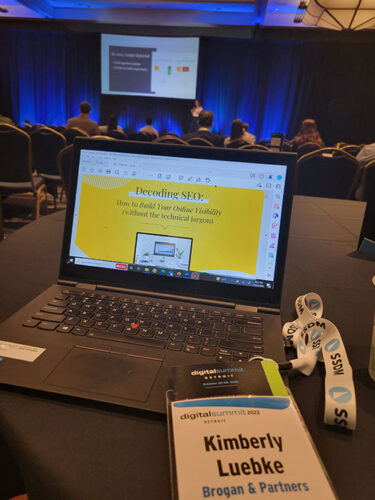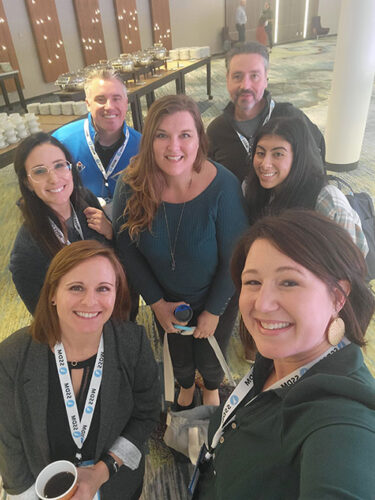
Last week I had the pleasure and privilege of attending Digital Summit Detroit 2022. What a reviving experience to be back, enjoying events in person after a long hiatus. The vibe and the energy were contagious. These are a few of my top takeaways:
- E-A-T your way to the top of Google.
- Leverage tech, but ultimately remember – you’re human, talking to humans.
- Silence is key to igniting creativity. Know the AABCs of Creativity.
E-A-T your way to the top of Google.
Thanks to Hannah McNaughton, founder and CEO of Metric Marketing, we confirmed our agency SEO practices are right on target. Getting ranked in Google is akin to building a relationship. You need to be likeable, knowledgeable and ultimately, trustworthy. Above all else, Google will reward you when you can showcase three things: Expertise, Authority and Trustworthiness (E-A-T).
The days of stuffing keywords and capitalizing on hundreds or thousands of backlinks are over. Focus on quality content and learn to stay in your own lane. Understand your audience so you can build a search campaign around them. These are the keys to SEO success.
Content is still king, but it must be helpful. In September 2022, Google rolled out the Helpful Content update. Google said, “Removing unhelpful content could help the rankings of your other content.” Work to build up your own website content to showcase your expertise, have author bios connected to articles you’re writing and externally – be sure others are talking about you or referring to you as an expert.
A few helpful tips:
- Focus on People First content:
- Do you have an existing or intended audience for your business or site that would find the content useful if they came directly to you? Ask yourself: Would this content still exist if it wasn’t for search engines?
- Does your content clearly demonstrate firsthand expertise and a depth of knowledge? Expertise comes from having actually used a product or service, or visiting a place – you have authority.
- Does your site have a primary purpose or focus?
- Do you have a lane, and do you stay in it? Why does your site exist?
- After reading your content, will someone leave feeling they’ve learned enough about a topic to help achieve their goal? Have you effectively covered the topic?
- Will readers leave feeling like they’ve had a satisfying experience?
- Content should be:
- Original, well researched, insightful (not simply an observation), expert-led, authoritative and trustworthy, well presented and free of grammar/spelling errors, embellished with appropriate multimedia content, so good people want to bookmark/share it. It should also reference supporting materials, provide a comprehensive answer and be accessible across any device.
- Avoid creating content for Search Engines first
- Is the content written primarily to attract people from search engines, rather than made for humans? Are you trying to appeal to the algorithms by keyword stuffing, etc.?
- Are you producing lots of content on different topics in hopes that some of it might perform well in search results?
- Does it match your site’s primary focus?
- Are you using extensive automation to produce content on many topics? Created by AI or written by humans?
- Are you mainly summarizing what others have to say without adding much value? Bring real expertise to existing conversation.
- Are you writing about things simply because they’re trending and not because you’d write about them otherwise for your existing audience? Are you jumping on unrelated trends?
- Do readers feel like they need to search again? Need to effectively cover the topic at hand.
- Are you writing to a particular word count because you’ve heard or read that Google has a preferred word count? (No, they don’t).
In addition, quality keywords are still important. Keywords are the main way your site is found by people and by search engines. Continue to think quality over quantity.
Lastly, ensure you’re using all the tools in your wheelhouse. Google Analytics tells you how users are interacting with your site. Google Search Console tells you how search engines are interacting with your site. Use tools like Lighthouse to check your core web vitals. Tools like Yoast assist with SEO. Stay on top of trends with moz. And make sure you’ve optimized your website. If your head is spinning, partners like us, at Brogan, can help.
Leverage tech, but ultimately remember – you’re human, talking to humans. With real emotions.
For years, Brogan has adopted the strategic prowess of the True Connection. Product Truth + Consumer Truth = True Connection. Advertising success comes in the form of the true connection, an emotional connection made, whether through the heart, mind or funny bone.
Throughout many of the sessions, there was a common phrase, “Be Human.”
Michelle Stinson Ross, CEO at Feelalytics brought “it” to her sessions – so much so I attended both. She reminded us that in advertising, there’s a fine line between persuasion and manipulation – it’s emotional. Creating connection is an emotional investment.
She confirmed how emotion impacts purchase decisions, sales and customer loyalty. As a marketer, it’s important to understand the difference between what we THINK customers feel vs. what we WANT them to feel vs. what they REALLY feel.
And Julia Calabrese, Global Interior Design & Brand Manager at Ford Motor Company, opened her talk with a level set about emotions. Human beings are capable of experiencing 34,000 emotions. And our emotional state changes second-to-second by the experiences we have. But there are only 2,000 words to describe emotions.
So, ask your customer for input! Most companies ask at the point of sale, and typically we’re relying on 20-year-old technology. The Net Promoter Score (NPS) is still a valid tool. But, how likely a customer recommends does not tell us WHY.
When you ask for feedback, your customers feel seen and heard. It’s an additional data layer. Every step of the consumer journey offers a differing insight. Thanks to Michelle, I walked away with a number of ideas and questions you can use to gain that “extra” perspective, depending on each stage of the customer journey. When you ask, ask for emotion. “How did you feel about… specific engagement… (making your purchase, winning a jackpot, using this app, etc.)?”
Awareness
- Ask: Did this article/page provide the information you were looking for?
- How: Leverage chat bot and pop ups
- Use the feedback along with A/B testing data for better user experience on your website and better conversion rate optimization
Consideration
- Ask: How do you feel after seeing the demo? How do you feel after using the sample?
- How: Ask questions during discovery calls and in follow up emails
- Use the feedback to better understand the customer’s goals and objectives
- Use the feedback to fine tune use cases for your products/services
Purchase
- Ask: How do you feel about the onboarding process? How do you feel about the level of communication with your customer support team?
- How: Ask during engagement with the sale and service teams.
- Use feedback to better understand if you are meeting customers’ expectations
And Julia reminded us, 86% of buyers would pay a premium for a good experience. We are in an experience economy. More emotional connection equates to more purchase decisions and more brand loyalty.
Silence is key to igniting creativity. Know the AABCs of creativity.
Lastly, Jenny Haggard, Global Creative Strategist at Spotify, delivered an insightful keynote. She focused on the habits that will open doors to creativity. And as marketers, our very livelihood rests on being creative.
She taught us the AABCs of creative marketing:
A – Anima
Anima is the unconscious part of the mind that works automatically without awareness. Its biggest enemy is noise. More noise – both internal (fear, anxiety) and external – lead to worse performance and concentration. We as a society are addicted to noise. The antidote: silence. Learn to develop a habit of being in silence, starting with one minute a day and building up your tolerance. Your anima will thank you.
A – Audience
Consumers, customers, clients… what are we all really? Human beings (remember I said that was a common theme).
Ensure you understand:
- Who is our target audience? Are you sure this is the current audience, or is it aspirational?
- What is unique, interesting or strange about this audience?
- Do we have the right people in the room to think about this audience? Creativity cannot exist with homogeny.
B – Brand
Your secret sauce equates to Audience + Anima. And when speaking about your brand, consistency is always better than intensity. Intensity is more valued, but consistency will make you more successful.
- What do I have that no one else does? Data, relationships, access?
- Why do people like (or not like) our brand?
- What does our brand sound like? Physical voice and tone of voice
C – Culture
What’s going on in your world, community, home? You can reflect it or create it.
- What’s going on in culture right now?
- What do we care about?
- Where do we have a right to play?
Following the AABCs of creative marketing will help you authentically connect to your prospects and generate the emotional connection you need to succeed.
So, are you feeling inspired yet? Google a new coffee shop, ask a friend to join you to share the new insights and relish a few moments of silence at the end of the day. We look forward to watching your creativity shine.
For more, see our Brogan & Partners blog.

























